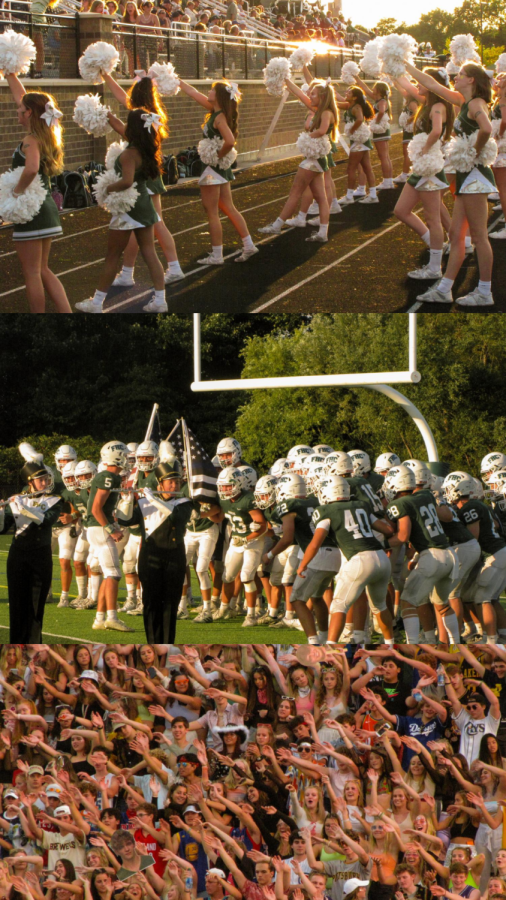Symbiotic relationships are essential to a football game

More stories from Lauren Brace
Images from an FHC football game in 2021, depicting only a few of the vital aspects to the game experience
The football arcs through the air, soaring through the goalposts—a successful point after a touchdown. The football is fumbled, tumbling to the ground—the beginning of a disheartening turnover. The football is victoriously caught after a quarterback’s desperate Hail Mary—the desperate pass proved successful.
These plays are entertaining to watch, but they’re not the elements that keep me enraptured in game after game.
When pulling up a quick Google search, “What is the most important part of a football game?” the only results are of the football team’s strategy and statistics. While I was fascinated by the teamwork and collaboration skills needed on a team and a couple of diagrams of what the football field looks like, it wasn’t until I got to some blog posts on the fourth search page that I found something remotely close to anything other than the mechanics of the game.
How could a “football game” make me one of the happiest people in the world when the word “touchdown” isn’t what excites me the most?
It’s because a football game isn’t just about the scoreboard; American football became popular because of the community that surrounds it.
While the team is essential to the game, the cheerleaders, marching band, fans in the student section, supportive parents, coaches, volunteers, and every person involved is crucial to create the experience that many Americans have come to cherish; however, their importance is not reflected in the media.
Highlight reels of a game center on the team’s winning touchdown and will occasionally pan over to a rambunctious crowd, but the cheerleaders, marching band, and dance team are lucky to have a second of their efforts highlighted. No matter how much time these three specific groups put into their performances and routines, they never receive the recognition that they deserve.
Every person is vital to the success of a football game; one cannot exist without the other. Many find it difficult to imagine a game without an audience, without coaches and volunteers to make everything go smoothly, without people to hype up the crowd and cheer on the team from the sidelines, and without the marching band blasting the fight song with every point received.
According to Forbes, the average amount of actual action calculated in an NFL game has been calculated to be between 11 and 15 minutes. This is an astoundingly brief amount of time for the ball to be in play while fans will spend an average of three hours sitting in the bleachers. This 11 minutes to three-hour ratio is applied to every football game, including the high school and college levels.
To state an example that I have a personal connection with: if the halftime show lasts for the same duration that the ball is in play, why don’t the marching band’s efforts receive equal acknowledgment in comparison to the football team? The various other groups involved in the game require the same hours of practice, teamwork, and spirit.
As we work towards keeping the exuberance and enthusiasm alive around America’s favorite sport, it’s important to stay attentive to the dedication that goes into making the other 165-169 minutes just as enjoyable to be a part of. Moving forward, schools and teams around the country should find solutions to make their peers on the football field and in the stands feel just as welcomed and appreciated.

Lauren is a senior entering her final year on The Central Trend as Podcast Manager. She has a strong passion for every extracurricular she's involved in,...





























































































Hailey • Oct 4, 2022 at 5:12 pm
YES! Band members and cheerleaders are required to go to all the home football games, yet football players aren’t required to go to a single band or cheer competition.
Anna • Sep 25, 2022 at 7:52 pm
Excellent article! I’m so glad you wrote about this. Every single person and group is needed to create the whole “football experience” and deserves recognition.
Angie Brace • Sep 24, 2022 at 8:04 pm
Very nicely written article stating how much is involved in creating the whole football game experience. Everyone works hard to make it most enjoyable.
Karen • Sep 24, 2022 at 2:23 pm
I’m so happy you wrote this article. It’s just how I feel. Hopefully you get a lot of positive comments.
Ren • Sep 23, 2022 at 12:57 pm
PREACH!